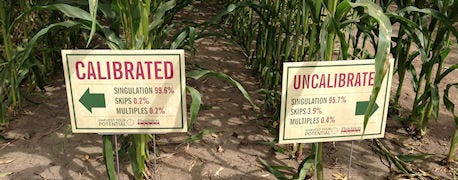April 13, 2014

By Tim Alexander
Diagnosing common planting mistakes has become a whole lot easier with the advent of GPS-driven precision farming.
Preventing those planting mistakes has become a function of both human perspective and modern technology, explains Doug Wiegand, regional sales manager for Precision Planting in Tremont. Improper planter speed and angle can cause poor seed distribution – the most common human error that technology can help correct during planting.

CALIBRATION TIME: Calibrating those seed meters should be a pre-plant ritual every year. It makes a big difference.
"A spring tillage pass prior to the planter that is not smooth, or is done on too severe an angle can cause a rough ride and extreme variation of weight carried on your gauge wheels," Wiegand says. "This will result in a lot of spacing errors due to an 'elevator' effect of the seeds being released, and due to more seeds ricocheting in the seed tube. It will also deteriorate the consistency in planting depth and of emerging plants."
Lot of variables
The proper planter speed is dependent on a lot of variables other than the meter itself. The quality of the row unit's ride, the consistency in weight carried on the gauge wheel, the meter's ability to maintain accurate singulation, and the ability to deliver from the meter to the ground a consistent spacing or placement from seed to seed all has an impact on yield potential from the planter pass.
"Spacing deterioration is most commonly caused from the drive system-- worn chains, worn sprockets, shaft misalignments, bearings going out and starter pumps connected to seed drive systems-- and rough ride of the row unit," Wiegand notes.
Determining optimum planting depth for seed is key to producing good yields and profits. Failure to find that consistent depth has bedeviled farmers for centuries. Wiegand notes that a planter row unit's gauge wheel is carrying moving-- not static-- weight and is more of a variable in determining seed depth than most growers realize.
"Managing down pressure on the row unit to achieve a small amount of weight on the gauge wheels at all times will help maintain a consistent depth," he explains. "Too much weight carried on the gauge wheels will start to create deeper-planted seed and also can delay emergence due to compaction."
A planter's row unit ride can also cause variation in weight carried on the gauge wheels when it is not smooth. This will also cause a variation of depth planted. The spring tillage pass, if done, should be done at either a very slight angle or straight with the planter to maximize the smoothness of the row unit ride on the planter, Wiegand recommends.
How'd you do?
Once the planter is put away, it's time to conduct a stand count to compare emergence to planting rate. Wiegand advises farmers to literally dig to the root of the problem when they encounter a skip.
"Always dig when you see a skip to quantify the reason why," he explains. "If there is a seed, did it germinate and leaf out underground?"
Is there an abundance of residue around the seed? This can be the cause of delayed emerging plants, and a row cleaner would help in minimizing that risk.
"If you have a lot of skips and doubles, calibration of meters on a meter test stand will minimize that risk," Wiegand advises. "Making notes of each skip, double and late-emerging plant in stand count results can help you to determine areas of management on the planter that need addressed."
In order to conduct an accurate stand count, Wiegand advises growers to measure off 1/1,000th of an acre (17 feet, 5 inches on 30-inch rows) and count the plants on each row across the entire planter in several spots on the field. Make notes of any skips, doubles, severe spacing errors and late-emerging plants.
Then subtract any plants that are one or more leaves behind in emergence, as they will struggle to produce a quality ear. A good goal is to have a final plant stand that is within 1,000 to 2,000 plants of the planted population.
Proper off-season storage and care of equipment, along with a good spring cleaning and maintenance, can help prevent errors made during planting season.
"You should always take your meters off of the planter as soon as you are done planting, clean them out and store them in a temperature-controlled environment," Wiegand says. "If your meter is vacuum or air, then remove the seed disc and store them vertically between seasons. Maintenance and calibration of meters, disc blades, gauge wheels, seed firmers, closing wheels and row cleaners should be done before each planting season."
You May Also Like




